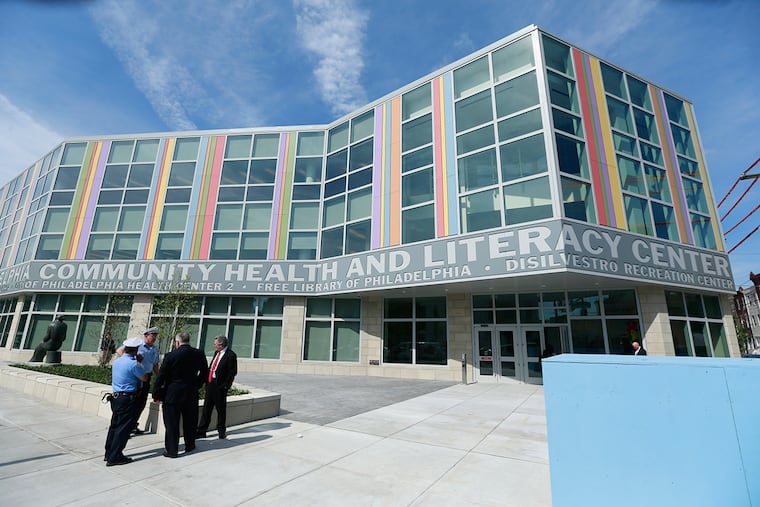South Philly center combines health, literacy, recreation
A new public health concept - combining medical care with recreation and education - came to brick-and-mortar life with Monday's opening of the South Philadelphia Community Health and Literacy Center.

A new public health concept - combining medical care with recreation and education - came to brick-and-mortar life with Monday's opening of the South Philadelphia Community Health and Literacy Center.
Parents can take their kids to the third-floor pediatric clinic and then visit the primary-care center a floor down for their own health needs. A branch library will soon open at ground level, with a special section where patients can learn more about their health issues. The new recreation center will open next month, providing exercise as a foundation for healthy living.
The $45.2 million, 96,000- square-foot building at the southwest corner of Broad and Morris Streets grew from an unusual public-private partnership that was celebrated Monday.
Combining "health care, literacy, and recreation" is "a real breakthrough" for the low-income, heavily immigrant community the center will serve, said Madeline Bell, president and CEO of Children's Hospital of Philadelphia, who joined Mayor Kenney in the still-empty library. Upstairs, the hospital's blue, orange, and green clinic was seeing some of what are expected will be more than 35,000 patient visits a year.
The combination of services is unusual, as is the cooperation among multiple city agencies and the medical center.
Five years ago, Children's Hospital's pediatric practice in South Philadelphia was the fastest-growing of its more than two dozen clinics, and it needed more space. Several blocks away, the second-busiest of the city-run network of primary-care centers was not only crowded but also leaking and rusting to the point where renovations made little sense. A library and rec center on the same grounds were out of date.
An effort that began with hospital officials asking about vacant land has yielded a square block of new construction where the old city facilities sat.
The link between good health and the physical activity that will be available at DiSilvestro Playground and Recreation Center is obvious. But the South Philadelphia Library's plans to offer literacy programs and computer classes are a key to well-being, too.
"Education is essential to being successful. And being successful isn't just from a monetary standpoint, but also from a standpoint of physical health," said Tom Storey, a physician who directs the Philadelphia Department of Public Health's system of primary-care clinics.
Health Center No. 2, as the clinic is known, had been getting 50,000 patient visits a year, most of them adults, and is expecting more. About 80 percent of its clients live below the federal poverty level and half are uninsured, slightly more than the systemwide average.
Among the 87 staffers are interpreters for Spanish, Indonesian, Vietnamese, Cambodian, and Chinese speakers; a phone interpreter service helps people who speak any of the two dozen other languages represented in the community.
Evidence shows that children are healthier if their parents are in good health, and officials are hoping that the grown-ups will take advantage of the visit to the pediatric clinic to get their own medical needs taken care of.
Two-thirds of the financing for the LEED-certified building, or $30 million, was provided by Children's, with $2.2 million from the city, $1.3 million from the Free Library of Philadelphia, and $9.8 million from a program that encourages investment in low-income communities. The city-owned land is leased at a nominal fee. The building was designed by the Philadelphia firm VSBA Architects and Planners.
Although the library is not furnished yet, a Maurice Sendak mural (moved from the Rosenbach) enlivens what will be the children's section, and a huge Wharton Esherick sculpture dominates the front section. (It was in a less-visible location in the old branch.)
The library, which gets more than 150,000 visits a year, will have about one-third more usable space than the old building, said Siobhan Reardon, president and director of the Free Library, and will be the first in the system to have separate study rooms. The staff is getting medical training from the University of Pennsylvania so that it can help patrons research their own health issues.
One nifty item, in the city's second-floor clinic, is a repurposed smart-parking-meter machine between the pharmacy windows and the exit.
It retains the original design, down to the red-yellow-green payment indicators, but works differently. While city health centers collect co-pays (the uninsured are on a nominal sliding scale), the staff don't handle money.
Instead, patients take an imprinted card to the machine and pay with cash or a credit card on the way out. But unlike failing to pay for parking, patrons who can't pay here don't need to fear getting the boot.
215-854-2617 @DonSapatkin